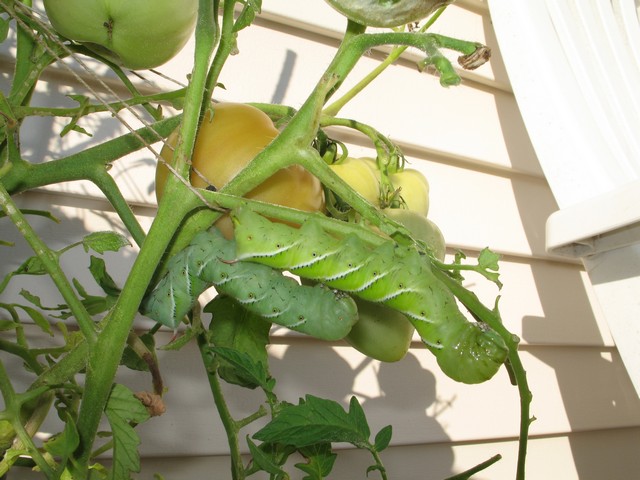
Several years ago I used to keep tomato plants on my deck (before my fenced in garden.) One summer I saw that my plants were wilting and not looking healthy, losing a lot of leaves and twigs. I figured I wasn’t watering enough. Despite better efforts, my plants continued to go downhill, looking worse every day, until they were missing most of their leaves and dying. I also noticed several partly eaten tomatoes still on the plants. I couldn’t understand what was wrong. While studying my plants, pondering what might have gone wrong, I suddenly discovered two large, fat, brightly green worms on one of the stems! I was both shocked and horrified at the sight! I had never seen anything like it! My husband did a quick search on-line and discovered that these two hungry caterpillars were tobacco hornworms, and that they are extremely common in North America. They cause a lot of damage to tomato plants, and will destroy them completely if left alone. These worms are often mistaken with tomato hornworms, which is closely related. It doesn’t matter much which type they really are, as they do the same damage, feed on the same plants, and are controlled in the same ways as well.
If you really want to know the difference between these two worms, there are a couple of things to look for: The tobacco hornworm has white stripes along its body and has a red horn, while the tomato hornworm has v-shaped markings and a black horn. I remember reading a little hint to help remember the difference: Think of the white stripes on tobacco hornworms as cigarettes, and the “V’s” on tomato hornworms as in “vine ripe tomatoes.” People also call them tomato worms, or hookworms. Tomato- and tobacco hornworms feed on tomato, tobacco, potato, pepper, and egg plants.
Since I did not known to be on the look-out for these nasty worms, they had been allowed to feed until quite large and plump, and finally nearly killing my tomato plants in the process. By the time they were removed, my plants were in such bad shape that there wasn’t much to try to salvage.
Look at the size of these worms!
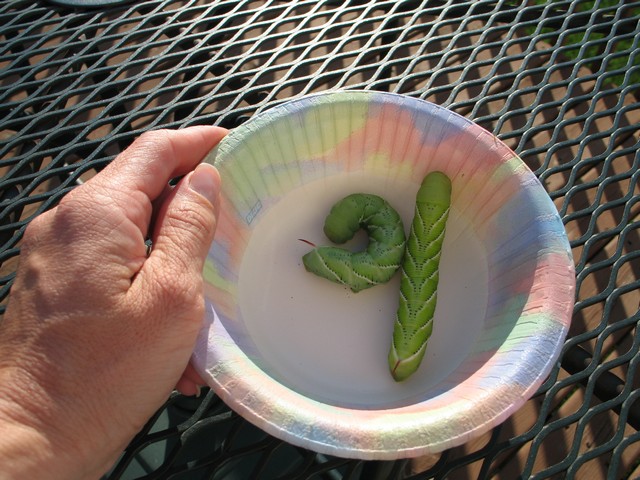
As you can see, they also have markings along their bodies looking like rows of eyes; possibly to ward off predators? It can be hard to know which end is the head-end; it is the opposite end of where the horn is located. There are also some claw-like “arms” by the head. They use their bodies and even the hind area to hang onto the branch, and they can hold on quite well. Ask me how I know! OK, I’ll just tell you right away: When I tried to pick them off, they held on for dear life! I often will use gloves when I peel them off, since I’m a bit squeamish that way. They gross me out! Their bodies are soft and squishy, and they have green goo throughout their insides. Don’t ask me how I know that one, I don’t wanna talk about it.
But in all reality, I have to admit that I find them beautiful at the same time. Especially when I see a picture of one. When I see a large worm on my plant, however, quickly and actively destroying what I’ve been tenderly caring for, I don’t find them so pretty!
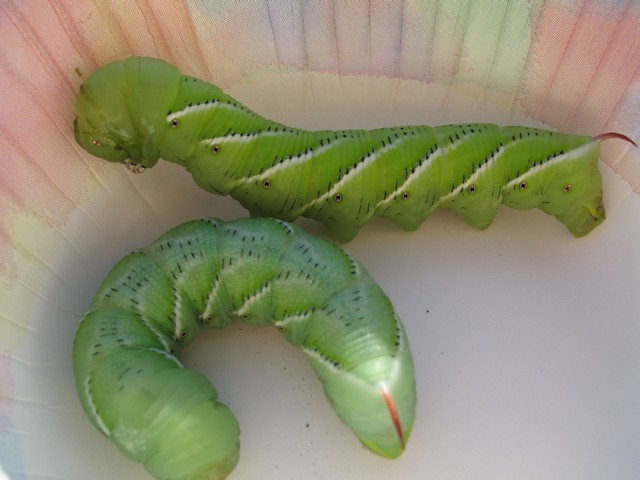
Ways to locate hornworms, clues to follow
On the next picture, you can see a small, black pebble on top of a leaf. This is a dropping, or poop, from a tomato / tobacco hornworm. These droppings, resembling small grenades, are a clear indication that a worm is nearby, and is one of the things I look for in order to find them. Finding the worms itself is tricky since they blend in so well, but if I see droppings like this, I typically look up a few inches and find a worm. Do you see the poop on the leaf and the worm toward the top in this picture?
Sometimes, especially when they are smaller, you may have to look under leaves in order to find the worms, but the poop is typically on top of the leaves as it obviously drops down from the worm and lands on top of leaves. Additionally, droppings can often can be found on the ground under the plants if several worms are present. You can also sometimes find little, green eggs underneath leaves, laid there by the adult moth; the moth of hornworms are sometimes called “hummingbird moths” as they can hover like hummingbirds when looking for nectar.
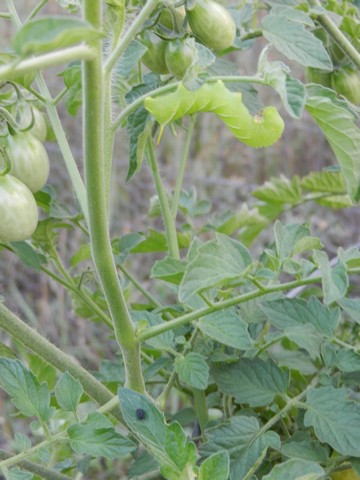
I also look for half eaten stems, twigs, or leaves on my plants, which is another indication of a hornworm infestation. If I find partly eaten green, or ripening fruit, that’s another clue to start looking around.
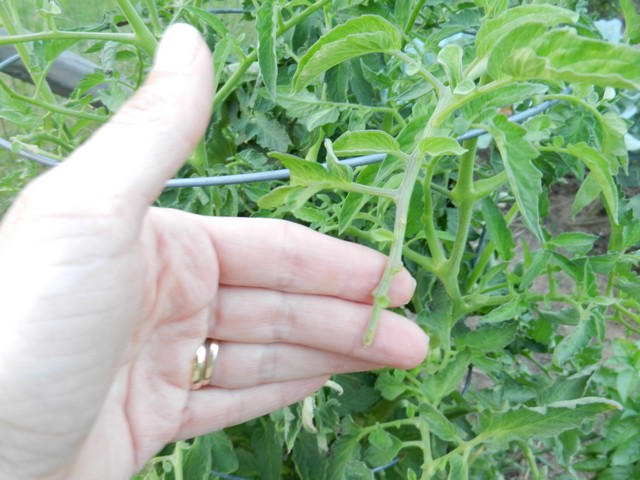
Here is a different plant with partly eaten twigs, and a worm directly to the left. This one is especially hard to see, but once you know where it is, you can see it.

See, right there!

Like I said, I’m a bit squeamish when it comes to huge caterpillars like that! I’m using my glove this time…
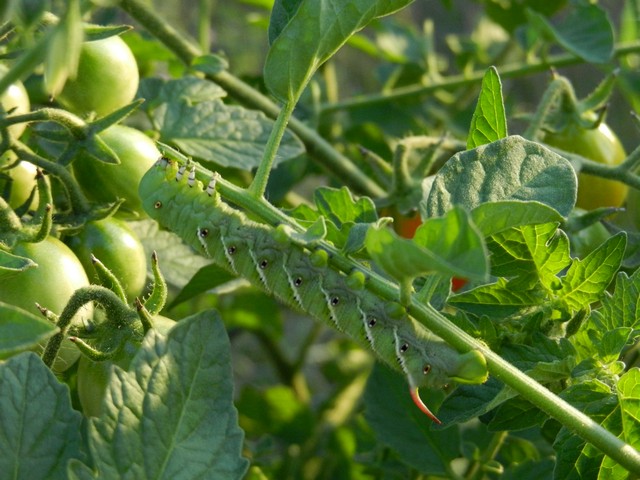
How to handle hornworms when you find them
Once you locate these worms, you can pick them off and discard of them by dropping them into a bowl of soapy water to drown, though some might find it more convenient to take care of things quickly, using a more direct approach. Otherwise you could put them on your driveway and let the birds take care of them. Chickens are also happy to receive such a juicy snack. Handpicking and destroying them is very helpful and makes a big difference, but if you are unable to check often, or simply have too many plants to control them that way, there are other things you can do to prevent them in the first place, or use for treatment once they show up.
Ways to prevent and treat for hornworms
One thing you might be doing already, is to till at the beginning and the end of the season; this will destroy a lot of the pupa in the soil; once worms reach a certain size or point of development, they will dig themselves down into the ground to over-winter, then hatch in the spring as mature moths (sometimes during the same season, even!), ready to mate and lay eggs.
You can also spray the plants with sprays that will control hornworms; there are a couple of different ones on the market that are considered safe for organic gardening. One of them is the beneficial bacteria bacillus thuringiensis (or Bt), which attacks and kills hornworms but is harmless to people, animals, plants, and the environment. Another spray for organic gardening that works well for a lot of different bugs, caterpillars, and beetles, is Spinosad.
When NOT to remove a hornworm
Another thing to be aware of, is that should you ever see a hornworm with protrusions on its outside looking like white grains of rice, you should leave these hornworms alone. Certain beneficial wasps will help you get rid of hornworms by laying eggs inside them, which will hatch and then feed on the worm, and finally make cocoons on the outside of it looking like white rice. If left alone to finish their life cycle, these parasitic wasps will help keep the hornworm population down as they seek out more worms to start a new cycle. The hornworms won’t do much damage at this stage as far as I understand, though I have never personally seen a hornworm infested by wasp larvae.
On the website Cahri’s Bugs Online, you can see pictures of hornworms in different stages of their life cycle. These pictures are helpful in learning what to look for in order to identify eggs and cocoons in addition to the worms themselves and their droppings.
Finding tomato or tobacco hornworms on your plants is not exactly fun, but it does add some excitement in the everyday gardening experience, as well as giving you another reason to get outdoors to enjoy the sunshine and warmth of summer. There might even be a story or two to be told in that regard, especially by your neighbors after they hear you shriek as you find your first one!
Just picked off 3 hornworms the other day and fed them to the chickens! The worms are so destructive!!
So nice when you have chickens to feed them to!
had to research, cause I have planted my first garden….on inspection today I seen what I thought was some kind of flower on my tomato plants, I touched it and it was squishy and then I looked closer and found it was a horned worm but it had white quill type things all over it, so went inside and googled away and yea pretty cool that the first worm ive ever seen in my life got hit with the braconid wasp larvae so im gonna watch its life cycle and leave it where it is.
That’s so cool! I have yet to see one with wasp larvae, but have had plenty of the other kind. It will be interesting to see how it all develops, no doubt.
I agree, it’s definitely disheartening to see plants that you’ve cared for since seeds destroyed overnight. Although, I guess I’m the odd one out in that I actually really like hornworms – I think they’re cute 🙂 Lately, I’ve been bringing them inside and raising them on pieces of left over bell peppers so that my tomatoes/peppers are safe, and my garden still gets to benefit from the adult moths, too.
That’s interesting! What are the benefits to a garden from adult months? Thanks for commenting, it’s fun to see the other side of this issue as well.
You know, a lot of people don’t realize that some moths are important pollinators, too. For example, the pitaya (dragonfruit) is pollinated exclusively be moths. The huge flowers open up only at night, when certain moths are active. Hawkmoths (which are adult hornworms, actually) are an example. There are lots of flowers that are pollinated by moths, especially morning glory, gardenia, tobacco, yucca. If you think about it, honey bees are not native to the Americas, which means that a lot of native plants depend on other flyers for pollination.
That’s interesting to know, for sure! Though I don’t believe in eliminating life that isn’t hurting us, it becomes a dilemma when something destroys our crops. In that case I do feel it can become necessary to kill off enough to keep us going. These worms may be beneficial to us in a variety of ways sounds like, but they sure will wipe out tomato plants in no-time if left to themselves.
That’s a little weird. Why would you want to raise these worms? What good would they do?
Apparently they help as pollinators. But the best pollinators are honey bees. With the amount of damage that tomato hornworms do, I personally would not want to encourage them. I’d rather have a box or two of honey bees.
I totally agree with you! Thank you for treating them with respect. The moths are really beautiful and they are beneficial night-pollinators. These worms ARE very important in the ecosystem even though they are always portrayed as pests.
I was thinking of using a blow torch, it seems a bit extreme but they scare the bejeezus out of me!!!
Oh my gosh!!!!! I have to agree! I garden on a small deck, and my plants were doing fine until a few days ago….so I thought, all the sudden they take a turn and low and behold I’m finding huge horn worms bigger than I’ve ever seen them and after I found one…..there was another….. etc…..no telling what my neighbors are thinking lol, because each schrill out of my mouth was louder and more horrified than the one before!!! I’m so grossed out now I feel like dumping dishwater on the entire lot!!!
Haha, how funny! And yet not for you at the time, sounds like! But now you have a funny story to tell. Thanks for sharing!
My sentiments exactly!
I just discovered these on my moon flowers. Overnight they ate about 3/4 of my plants. Pulled off about 30…… What causes these to appear practically overnight?
Wow, that sounds horrible! Quite the infestation, and yes, they can be terribly destructive! Why they came so suddenly: Well, maybe they all came from the same egg laying moth and hatched at the same time, that could be one explanation. Spinosad is a great spray to keep them away, and is considered OK for organic gardening, so it is supposed to be harmless to humans. I have had great success with that. Works for a lot of insects on a lot of plants. It’s not fool proof, but it helps a lot.
After removing the worms can my tomato plant be saved? I came back home after a couple days away and found the top of my potted grape tomato plant gone. I have two and 1/2 clusters of tomatoes and a few blooms left along with lower foliage. Also, my tomatoes are large but still green, is this due to the worms or some other problem? This is my first time planting.
I would say that the plants can be saved if there is a bit of healthy parts left. Don’t give up on them yet! 🙂 They need to have a bit of leaves left for photo synthesis, and it sounds like there is some, at least. As far as with the tomatoes, they will keep growing for a few weeks and stay green until they are done growing, then they will very slowly turn a lighter green, yellow, orange, then finally red. It can take a good while before they start changing colors, so don’t get discouraged. Just keep up the good work, be patient, then eventually you’ll have beautiful, deep red tomatoes on the table. 🙂 Happy growing!
Just found two large hornworms on my tomato plants and they did have the white rice like spikes on their bodies. I wish I had read this articles first as I pulled the worms off the plant and killed them. Now I find out the wasp infested hornworms are actually good as they will attack additional worms. But I couldn’t stand the sight of them on my plants. These worms had also stripped a bell pepper plant in one day. I will get some of the BT and spray the plant in the morning.
Yikes! Never fun to find them, but I’ve never personally seen them infested with the wasp larvae. Honestly though, even though you are supposed to leave them alone, it would be hard since it seems the worms would continue to destroy your plants. I wonder how active they are able to be once attacked by the wasps? Seems like they would slow down before they eventually die? Maybe transfer them all to one plant and spray the others to save some… Just thinking out loud here, in case they should ever show up w/ wasp larvae in my garden. 😉
Hind sight is 20/20. I just killed 4 worms and one was an egg carrier (I thought they were eggs for the worm itself). First egg carrier I ever saw and I am soon to be 65 and tended tomatoes since I was little. It was much smaller than the other 3. It was being cannibalized I realize now. I thought they were never anything but a worm. If I assume the moth laid 4 eggs and assume they would have been much the same size, that is a terrible way to die. There had to be about 30-50 eggs on it. It was not moving much! Got to go look up the moth now. :-O
Yeah, sure doesn’t sound like a very pleasant way to go… Slow and painful!!!!! Not sure how much pain they feel, but I guess I’m OK with not knowing… 😉
You can also feed them to a pet reptile like a type of lizard but not snakes remember snakes eat mice birds rats eggs snails well snails for baby gopher snakes or another type of snake but I forgot its name anyway I gave some of them to my pet bearded dragon and I need to say he loved them and the only reason of why their poop will look green is because that is the color of their poop when its fresh but it’s even more green when he poops after he eats them because exactly of what the person on here giving you information about them and how to get ride of them she said they have green goo inside of them and I found that out myself too it’s their poop and when its liquid what do you think it is anyway like I was saying its even more green because of the lizard eating it and pooping it out but even though he really likes them instead you should just buy crickets for him their a lot healthier for him/her.
We have peppers and tomatoes in containers on our deck. We were out of town for a week, came home to find most of our plants stripped down to stems! I have found and picked off about 8 of the caterpillars so far (little ones and big fat ones) Right now I have them in a terrarium in my family room but will give them to my neighbor for her chickens this afternoon. Yuck! I don’t know if I can salvage my plants or will have to start from scratch (we have 2 growing seasons here in Florida, fortunately) I guess I’ll have to dump all my soil and start over?
Oh no!! 🙁 What a bummer! Sounds like you have enough time in your region to start over, so that’s what I’d do. It should not be necessary to throw out the soil though, just fertilize to make sure there is plenty of nutrients there. If you’re concerned about transferring the worms to new plants, I would not worry about that. The worms get there from egg laying grown moths, so the soil is not the problem, though the worms do burrow down later in the season. I forget, but I think they then emerge and become moths… which will fly around to people’s plants and lay eggs. Point is, there is no reason to throw out the soil. You could get a hold of a bottle of Captain Jack’s spinosad, and spray every 3 weeks to prevent a future problem. This spray is safe for organic gardening even, and is VERY helpful in keeping these worms out. I use it on my broccoli as well.
I didn’t know what they were when I found about six HUGE ones…I threw them about 10 feet away just to get them off of my plants…will they be able to crawl around until they find them or will they die before that?? If I find more the chickens will get them.
I’m sorry for the late reply. Unfortunately, I have heard of them finding their way back to the plants again, so they really should be disposed of once and for all. Just keep checking your plants and look for symptoms of a problem.
Hello, I’ve noticed for the first time, the twigs of my husky tomato plants being eaten along with some of the top leaves of the plants. The droppings are actually on the very most top leaves of the plants (not as you described). Is it still possible that I have hornworms on my plants? Thanks!
Sorry it’s taken a while to get back to you, I was not able to log on for a while.
Definitely I would suspect horn worms even if the droppings are on top. There’s no reason these worms would not climb to the top, or anywhere else. I think the droppings often will fall lower down eventually, but I’m sure they can remain on top as well. Hope you have found them by now and gotten rid of them!
Yikes, one of my roma tomato plants started looking really sick, I had been clearing away all of the dead leaves, etc… yesterday laying on the ground was a bright green hornworm I thought it was a leaf until it stretched !!!
I looked up on the internet to see what I was dealing with – and thanks to your website am now a bona-fide hornworm hunter!!! thank you for all the info.
Oh my, thinking it’s a leaf and then you see it stretch, I would have screamed I’m sure! Glad you found my post helpful!
I found one with all of the “rice coccoons” on it. We are keeping it as a science experiment to observe….
Does anyone know a reason they should even be here? I found three of them last year on a plant that had a lot of tomatoes on it. They creep me out, my grandson finds them and kills them. He hates them. Are they good for anything?
I don’t know what they are good for other than that the adult moths supposedly help pollinate plants. But yeah, they are creepy! They’re kind of pretty too, I think, but they’re creepy if you all of a sudden come upon one unexpectedly or have to pick them off from plants! Ewww!!
Thank you for the helpful tips…
I just went to check on my baby tomato seedlings after reading about these horrible worms. . .when all of a sudden i noticed two little grey things crawling on my carton…the same grey color as my carton. And the little “worms” (or whatever they were) were crawling around doing i’m not sure what??? Maybe eating my seedlings, since i only have about 3. I’m not sure if that will be enough to start my garden or not?
Weird, cuz I found a snail crawling on another plant that I transplanted earlier. What could these things be…and where did they come from…Maybe the potting soil that was out in a tub during the winter…and some other plants that had died off, and I saved the wet soil to mix with the dry soil.
Yikes! No fun! I’m not sure what the worms are, could be just about anything. But definitely hand-pick them off and get rid of them. Then spray with Captain Jack Deadbug, which contains spinosad, or there are other organic and non-organic things you can apply as well. I would try to eliminate now. So do you have these plants inside? If you used soil from outside, I’m thinking that’s where the worms (or eggs) came from.
And assuming your seedlings are OK for now, 3 plants might be enough unless you’re going to can a ton of sauce and salsa etc. Just protect them so they’ll grow for you, then you’ll probably be fine. I’ve never had small tomato plants die on me, it’s more an issue of whether the seeds sprout or not. Once they’re up, I keep them moist and in a sunny spot. I plant outdoor once the risk of frost is over. That works for me, and I’ve been OK with only 3 plants before. I hope the worms didn’t eat the roots or attack your plants. Hope you’re able to get rid of them!
Thanks for posting about this problem with such detail. I was wondering what was eating my tomato plants and leaving so many weird green droppings. After reading your description above I went back out and promptly found one happily munching away to my chagrin. Couldn’t find another but now I’ll be looking. Thanks again, Jeff
You’re welcome! Amazing how they just appear from out of nowhere, but at least you caught one of them. Keep on checking throughout the season! 😉
I have found 7 on my two plants just in the last 3 days!!!! Two of them had the white larvae on them. Creeped me out!!! I can only assume there are more in the soil ?? I thought maybe my soil was bad that I bought and they were already hiding in there?? Three of my small green tomatoes had to be pulled off. The rest seem to still be growing ok. Is it ok to still eat the tomatoes after finding these creatures all over my plants??
Yes, definitely still use the good tomatoes on your plants! But yikes, that’s awful to find so many!!! I have found that they sometimes will eat from the tomatoes themselves, and I would not use those, obviously. But the ones that are whole and seemingly untouched should be just fine to use. Regarding the soil, I highly doubt that they were in the soil that you purchased; generally such soil is “sterile” and clean. I’m sure that they were in your own soil, but that doesn’t mean your soil is bad. There will always be some diseases lurking, and you’re never going to have perfect conditions. So we attack problems when they come, also remove diseased materials to minimize recurrent problems. 🙂 Don’t fret, just do your best to deal with it and enjoy the good that’s still there! 🙂
Thanks!! i was so freaked out when i kept finding them, just so weird!!! i have checked at least 10 times today, and there are no more, so I am hoping that was all of them!!
Yes, you may have caught them! Keep checking now and again, or spray with Captain Jacks (has spinosad in it), which is fine for even organic gardens. This takes care of it for 3 weeks, even after heavy rains. That’s what I do, and it gives me peace of mind. I buy the concentrate, which lasts a long time.
Thank you, Terese, for a very informative post! I picked 5 of the little monsters off 2 of my 3 tomato plants this evening and let them soak in soapy water. Tomorrow I’m going to find the Captain Jack spray you recommended; so happy that I can keep my garden organic by using it. Thanks again!
You’re welcome! I too am thankful there are alternatives that WORK, so chemicals can be avoided.
I, too, was horrified to find these worms on my cherry tomato plants. My solution, as I don’t want wasps around either, was to take a large pair of scissors & cut them into several pieces. I know, it was mean but satisfying!!
They are creepy when you don’t expect to find them, that’s for sure! 😉
I was using coffee grounds to try and deal with ants and couldn’t understand how they were landing outside of the container and on leaves….until yeseterday. While clearing leaves in the middle of my plant, something moved. Shock subsided and I starting taking photos. My husband came out and used chop sticks to remove it, and then another, and another. Using chopsticks may not be the best idea, green goo eveywhere, and they fight like mad-like something out of a bad B movie. Thank you do much for your photos and info-so wonderfully straightforward and helpful!
They seem to fight no matter how you get them; makes me feel bad for them, but not bad enough to let them stay… And I have used coffee grounds successfully to get rid of slugs from a basil plant, it worked very well. 🙂
Ewwwww thanks so much for your website because I didn’t have a clue what I had – they sure do blend in with the plants & leaves. Decided to put the 3 plump worms in the driveway for the mourning doves to feast on!!
To kill tomato worms naturally, mix some liquid dish soap and water in a spray bottle, spray it on the tomato plant, and then shake some Cayenne pepper onto the plant and on the tomatoes. The soap kills the worms, and the cayenne pepper will keep them away if the soap washes off of the plant and they try to come back. Some people just use the soapy water to kill tomato worms naturally and don’t bother with the cayenne pepper.
Great advice, thank you so much!!
There’s only one good thing about horn worms….catfish bait, when I was younger I found one and put it on a hook it lasted long enough to catch 3, from 4 to 7 pounds. Works better than catalpa worms.
Sounds like you did very well! Thanks for the tip, I’ll have to let my son know. He loves to go fishing!
Thank you! I found tobacco hornworms on my potted tomatoes just as you said! I found the poop then the missing leaves and amputated stems then the pretty fat devils.
Gracious! They never stop, do they?!! Good thing you found them, hopefully your plants will be OK.
Just found my first hornworm, covered with wasp eggs. Never seen one in 50 years of growing all types of tomatoes.
That’s a lot of years of experience! Wow! I have yet to see one with wasp eggs, it does sound so nasty! But good thing these wasps are around to help us out!
Befriend a family of cardinals. They have been very helpful in keeping the worm population down. I added a bird feeder with black sunflower seeds to encourage my bird friends to hop up to the buffet.
Hi…just found these awful worms yesterday. 2 in the morning, and out of nowhere, 2 at night. I just found another one with those wasp sacs. Unfortunately I had to get rid of those too. I’m highly allergic to wasps. My question is are the tomatoes safe to eat? Mine are on my cherry tomatoes, and I pulled a tomatoes off the vine an ate it, as I always do, and something didn’t taste right. That’s when I immediately saw these worms! GROSS! I thought I was gonna throw up! Anyways…after the Virginia story, are the tomatoes safe to eat?
I can definitely understand that you felt you needed to remove the one with the wasp eggs. Those types of allergies can be nasty.
I do believe the tomatoes are safe to eat, although I would not want to eat one that a worms has been eating. Usually the worms eat mostly stems and leaves, but sometimes they will also go for the fruit in addition. When they do, it’s pretty obvious on the affected tomatoes. They eat quite a bit before moving on, leaving a large open area, obviously eaten. But as long as the fruit itself looks fine, it should be fine. That odd taste is probably completely unrelated. The plants are not diseased, they’re just munched on, but then of course they’ll die if too much green has been eaten
Hi, I have container tomatoes and used organic potting soil and black cow. Is it possible the tomato worms came from the black cow? Last year I just used the potting soil and had no problem..Thanks
I doubt that the worms came from the soil or even the Black Kow. Cow manure is completely composted by the time you buy it in bags, and I don’t believe there’s anything living in it anymore. The worms probably came from eggs laid by the mature moth. Even if they came from the soil and you switched to a different kind, you still would not be protected since moths fly everywhere and could come by and decide your plants are the perfect spot for their offspring. Sorry, wish I could give you guarantees with new soil!
Love your website it’s been very helpful! I’ve pulled one worm off & a mockingbird enjoyed it. I sprinkled diatomaetous earth all over my 2 tomato plants in pots. Do you think I still need the organic spray? There were a couple small green tomatoes that were partially eaten as well as leaves & stems. But enjoyed a delicious bacon & tomato sandwich for breakfast this morn…these are the biggest tastiest tomatoes I’ve grown in a few years.
Thank you! And that’s great that you’re enjoying tomatoes already, how nice! As far as diatomaceous, I’m not actually familiar with it and don’t know if it protects against worms and insects. But from the tiny bit I just read in this link, it looks like it might be enough. I didn’t read the entire article (too busy at the moment), just enough to guess that it might work. I would pay attention though, and also pick off any worms that you might find, also look for clues to see if more might be present. But if you already used this product, I would try that first and not double up with other sprays unless I see that the first product didn’t work.
https://www.hunker.com/12470386/how-to-use-diatomaceous-earth-for-tomatoes
I found a natural recipe that really helps in controlling tomato hornworms. Add about 2 teaspoons of liquid dish washing detergent to a small spray bottle. Fill about half full of water. Shake really well and spray both sides of the leaves on your tomato plant. While the leaves are still wet, shake cayenne pepper lightly on the leaves. The tomato hornworms do not like the hot peppers of any type !!!
I hope this controls your problem as it has done mine. If all else fails you can spray with Neem Spray. It can be used on any vegetable plants as late as harvesting day. It doesn’t hurt humans or animals but it kills bugs. Neem Concentrate can be purchased at Lowe’s Stores or most gardening supply centers and you take it home and dilute it following the instructions on the bottle. Neem is a plant that is used in formulating the Neem Concentrate.3
Great information, thank you very much for sharing! I am sure that the dish liquid combined with cayenne will be very helpful. I’m thinking one should reapply after heavy rain or over-head watering. The Neem concentrate is also very interesting. I really appreciate you sharing these suggestions!
Found my 1st work yesterday with little white quills all over it’s body. I thought it was a weird bloom or growth on my tomato plant. I pulled it off with a stick and dropped it bucket of water. This is my 1st year of gardening….just patio plants. I have enjoyed it and learned alot. If find another work…..I’ll save it for the birds…..yuck! Yes they are kind of beautiful in their own way and gross at the same time. Thanks for the info…….very helpful.
You’re welcome! Yes, I agree, beautiful and gross at the same time. Funny that that’s even possible!
I picked off about 12 worms from 4 plants last night. I’m an grossed out by these things also. I even moved my garden this year in hopes of avoiding some issues that come from gardening in the same spot every year. I won’t be back to my friend’s house to check them for a few days. I hope I have plants left when I get there.
You are very kind to go at it at your friend’s house, helping her by removing these destructive critters. It is very helpful to get rid of the ones you do see. Just take a look again next time you go. Hopefully you got them all.
Hi, my tomatoe leaves are not really chewed up or missing but something is eating my tomatoes. I can’t find no worms although that doesn’t mean they’re not there what do I do help please
Could it be chipmunks or other animals? I would still look for evidence of worms or other pests. If you suspect chipmunks, try to spray paint some rocks red, and put them near the plants. When they try to take a bite out of them, they quickly learn that these red “things” in your garden are nothing good to eat. Or so I’ve heard. 😉 They say it works for strawberries, so maybe tomatoes as well? I hope you figure it out, this is not fun! 🙁 What a bummer!
Here in south Texas we use flashlights with ultraviolet LEDs to hunt scorpions at night. They fluoresce under UV light. I discovered that the horn worms also fluoresce under UV light making them very easy to find at night, even the very small ones. If you have a lot of tomato plants, give the kids a couple of UV flashlights and some needle nose pliers…….no more horn worms and fewer scorpions as well.
Oh wow, what a great suggestion! I had no idea, that’s awesome! Thank you so much for sharing!
I didn’t know about these guys until checking my garden tonight. Found two big ones before researching what they were. Then noticed a bunch of leaves on top stems were missing. My sister had to use tongs to pull them off (squishy things and she was squeamish with it) while I had a flashlight and a bucket of soapy water positioned right underneath just in case they fell. Man, those guys have a strong grip! Nearly clipped off the end of that stem if we couldn’t pull them off. Will be checking the garden again tomorrow to make sure there are no more.
Thanks for all the info and tips!
What should I do if I find one of the moths early in the season? Any tips? Is it really obvious that I should just kill it? But how? I’d rather squash a caterpillar than a big furry moth. 😬
All of this information still applies early in the season. Hopefully they will hold off for a while, for you. But if they do come early in the season, you’ll need to deal with them then. It’s really up to you what you want to do with them. Not everyone agrees with killing them, but personally I am okay with it since they destroy crops that are meant to feed humans. It isn’t a fun job to kill bugs I dont’ think, but I also will not allow myself to feel too sorry for them. I never kill anything for the fun of it. As far as how to get rid of them, some people will squish them, others dump them into soapy water for them to drown, some will spray their plants with Captain Jack’s spinosad spray, and yet others will feed them to their chickens. I’ve also heard of throwing them into a lake to feed the fish. I wish you a wonderful growing season with no pests to deal with! 🙂
Found seven combined on two plants. They must have had a party last night, I do look. Question, should I remove branch they they are all leafs on. My first year growing.
Thanks
Seven is a lot of worms! I’m glad you found them now, before they destroyed your plants completely. I would absolutely not remove the branches, it should be sufficient to only remove the worms themselves.
I have been gardening for most of my adult life, approximately 40 years. I’ve always had a great harvest, but this year all my tomato plants were getting brown. I thought that it was because our spring was very wet, and our summer so far is very hot and dry. I was starting to notice that the limbs on the plants were falling off, so I actually was clipping them off as long as they didn’t have tomatoes on them. I reached for a branch…..and there it was, a hornworm with wasp cocoons in tow. I have never seen a hornworm before in all my years of gardening. What a sight to see. Now I have quite a job ahead of me. PREVENTION!!
Oh wow, that’s incredible that you’ve never had to deal with them for all these years, good for you! And then the time that you find one, you find it with eggs and all! As you may have found out by now, it’s best to leave them alone if they have wasp eggs in them, since the worm will die anyway and this is a way for these beneficial insects to reproduce so hopefully it will help cut back on the hornworm population for all us gardeners. I hope you were able to get a decent harvest still! Have a great upcoming fall season!
Can you use a black light to see and find them?
I don’t know, I haven’t tried that.